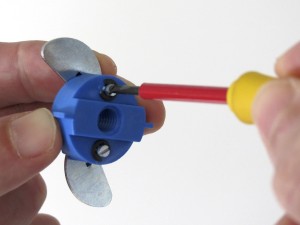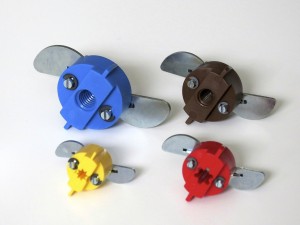Grip It fixings
Grip It is a type of fixing designed for use in hollow walls around your home. By hollow walls, we’re talking about stud walls where plasterboard is attached to timber uprights, or drylined walls where plasterboard is secured to the blockwork below using dabs of adhesive. In both instances, there are large voids below the plasterboard and so you need a special design of fixing to ensure that whatever fitting you’re going to hang on the wall, it’s safely held in place. Now there are plenty of designs of fixing on the market that do cater for this need – some are shown in my guide – ‘Fixing into hollow walls’. However, Grip It fixings take this situation a step further by providing a range that is designed to bear much heavier loads than all other options.
How do Grip It fixings work ?

Once the Grip It fixing is positioned snugly in the plasterboard, you turn the little screws to open up the flaps inside the wall.
At the required fixing position, you drill a hole which has a diameter that must be the exact size specified for the fixing. For example, the blue 25-2 fixing shown to the right requires a 25mm hole. You can use a spade bit or holesaw, but be sure to drill as precise a hole as possible.
Continue to follow the guidelines on the pack about gently tapping the fixing in to the correct depth (a little depth gauge is provided), but make sure you don’t tap too hard, or you will lose the fixing inside the wall! After this, the clever bit comes, as you then use a screwdriver to open the flaps at the back of the fixing. These flaps prevent the fixing from pulling back through the plasterboard, and are the main reason that these little beauties can be used to hold such substantial weights.
Depending on the size of fixing you have used, either a bolt or screw is inserted in the central hole of the Grip It fixing, to hold your chosen fitting in place.
Grip It fixing sizes

There are four sizes of Grip It fixings, and you simply choose the one that best suits the loading you require.
Grip It fixings come in a range of 4 sizes. The company literature states that for the smallest option you can achieve a maximum shear load capacity of 50 Kgs, and with the largest fixing, it goes up to a massive 180 kgs.
They do halve these figures with a suggestion for shear ‘safe’ loading, but that still means 90 kg for their largest fixing.
For those of us who have trouble picturing that sort of weight (which includes me), we’re looking at nearly 4 standard bags of cement, or about 1400 eggs, or around 25 X-Box 360s, or nearly a whole Usain Bolt. Quite staggering really, and certainly greater than equivalents in the market place.
Uses and limitations
I’ve literally only just come across Grip It fixings, at Grand Designs Live last week, but I did have a very good ‘play’ with them, asked a lot of questions, did the demo, and spent the last couple of days with some further experimentation. So, my conclusions go like this…..
- First up, they do work, no doubt about it, but because plasterboard is so easy to damage, you really have to be careful when making your hole, as any crumbly edges need to be avoided.
- I think they rely on some form of fixing plate (as supplied with most TV brackets for example), or fitting that clamps tightly against the wall (a hook for example), in order to provide a really secure anchoring point. In other words, if you just use the Grip It fixing with a screw or bolt on it’s own and hang, for example, a heavy picture directly from it, I’d imagine this could distort the position of the fixing in the wall and therefore compromise strength.
- With regards to price, they are a little more expensive than other options, but Grip Its do take heavier loads, so I’d say they’re really good value for money. And of course, you can reuse them! Most hollow wall fixings may only be used once, but with Grip It, you just rotate the little screws to ‘close’ the flaps and pull it out the plasterboard.
- I think that they’re primary use would be in stud walls where the vast majority of the area below the plasterboard is a void, as with drylined (dot and dabbed) walls, I’d be a bit concerned about hitting the edge of dabs of adhesive too often, so I’d be more likely to use extra long plugs and screws in these cases, and fix directly to the blockwork.
All said, I think Grip It fixings do present a viable option when trying to create a secure fixing point in stud walls. I’d always try and fix into the wooden studs if possible, but let’s face it, they’re rarely in the ‘right’ place. I’m not sure I’d feel confident to hang really heavy stuff off them yet, as I need more evidence, demos, and real life examples, to convince me of their astounding loading capabilities. To me, it feels a bit like that advert they used to show with the bloke dangling on a section of wall from a helicopter, held only in place by the strength of some wallpaper paste – you just sort of think …..really?!
Grip It are a British company, the fixings are made in Britain, and it’s great to see how these guys have clearly worked hard to get a great idea to the market. Therefore, I do hope that one day they’ll be able to crush any of my reservations about they’re really heavy-duty uses, as if they can convince a ‘new product cynic’ like me, they’ll be able to convince anyone!
Grip It fixings are available in plenty of independent retailers, as well as with the big boys like Wickes and Amazon.I’d recommend giving them a go!
For more information check out the Grip It website.
